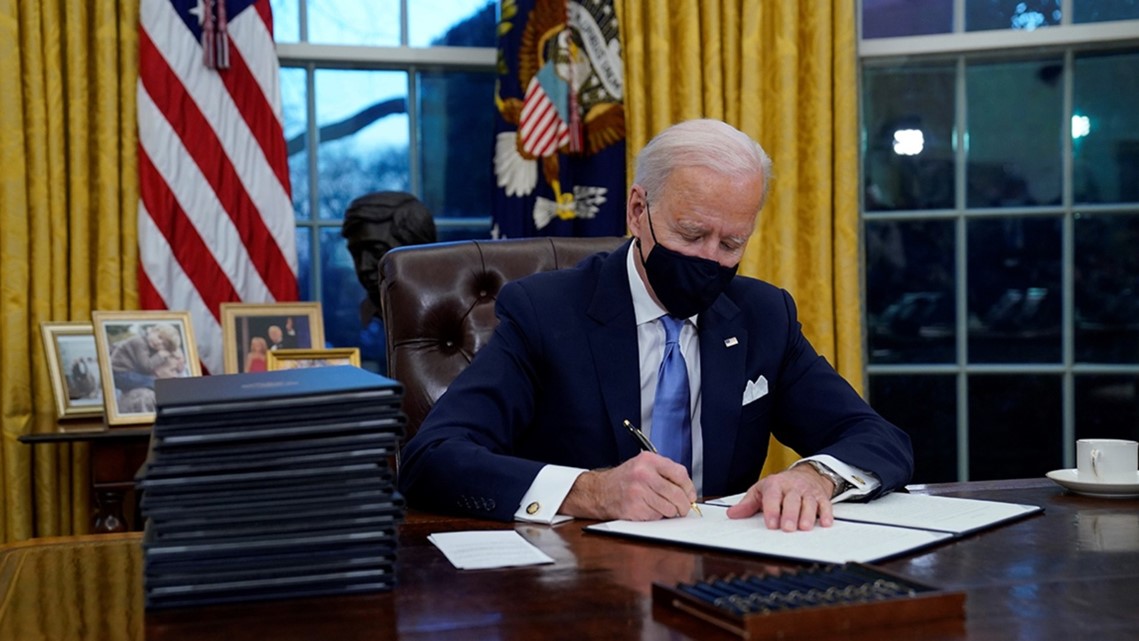- Grid Infrastructure
- Renewable Energy Innovation
- Siting & Permitting Reform
- Supply Chain & Trade
- Transmission & Power Markets
- Blog
Accelerating Renewable Energy with the Whole-of-Government
By: Tyler Stoff
February 11, 2021
The new Biden administration can use its executive authority to accelerate the deployment of renewable energy in a variety of ways. Part one of this series explored how the Federal Energy Regulatory Commission (FERC) can leverage its authority to accelerate the transition to a renewable energy economy. This blog will focus on the additional tools available through the White House itself, the Department of Energy, the Department of the Interior and the Department of Agriculture.
Within hours of taking office, President Biden began to chart a new course for the federal government, one that takes climate change seriously and places renewable energy center stage. He recommitted the United States to the Paris Climate Agreement, set a nationwide goal of 100% emissions-free electricity by 2035, expanded offshore wind targets, created a working group to ascertain the social cost of carbon and incorporate it into federal permitting, suspended the investment-chilling Bulk-Power System Executive Order, directed ambitious federal renewable energy and electric vehicle procurement goals, and called for greater transmission investment, among other initiatives. While the administration is off to a running start, there is even more it can do to expedite the energy transition.
-

President Biden signs Executive Orders shortly after taking office. Source: Associated Press The White House can build on strong initial climate action by taking the lead on renewable energy permitting and right-sizing tariffs on important solar and wind components. Modeled after successful renewable permitting reforms in states like New York, President Biden should consider appointing a senior official to ensure that each agency with permitting authority over renewable energy projects coordinates their processes and uses criteria that recognize the magnitude of the climate crisis. Each permitting agency should also take greenhouse gases into account in their environmental reviews. Additionally, Trump-era tariffs on solar and wind energy, including both on finished components such as solar modules and raw materials such as steel, not only raise the cost of the renewable energy transition in general, but they disproportionately affect renewable energy over fossil fuels. These tariffs should be immediately reassessed.
- The Department of Energy (DOE) can uniquely remake our electric grid through both technology commercialization and policy innovation. DOE’s research and development programs have an impressive track record of invention. Through an overarching focus on deployment, such as by making commercialization and pilot or demonstration projects an explicit goal of research and development and continuously measuring the success of the SCALEUP program, DOE can help ensure that innovative technologies really do get across the commercial valley of death. New research should also launch or expand to solve industry-wide challenges, such as long-duration storage, inexpensive high-voltage direct current transmission and end-of-life materials recycling. Loan guarantee programs can also be made more user-friendly and opened to transmission, which can enable the grid buildout necessary for cost-effective renewable integration. Additionally, a renewed focus on building codes can help advance economy-wide electrification.
The Energy Department’s National Renewable Energy Laboratory should follow up on its groundbreaking Interconnections Seam Study by exploring how to build a nationwide, high-voltage Macro Grid using current Power Market Administration authorities and existing rights-of-way, how to plan transmission for 30 gigawatts (GW) of offshore wind, and high-quality analyses of decarbonization resource mix scenarios by region and power market. Delegating department authority to FERC to designate Federal National Interest Electric Transmission Corridors can streamline transmission permitting by centralizing federal authority within a single agency. Relatedly, DOE’s triennial National Electric Transmission Congestion Study should be reimagined to focus on addressing future congestion and aligning transmission with the nation’s rapidly changing resource mix in light of the ongoing climate challenge.
- The Department of the Interior (DOI) can expand and expedite renewable project permitting on federal waters and lands within its jurisdiction. Through the Bureau of Ocean Energy Management, DOI can pay special attention to speeding offshore wind leasing and permitting on both coasts, such as by finalizing the Supplemental Environmental Impact Statement for the Vineyard Wind project and issuing a Record of Decision, issuing Notices of Intent for projects with completed Construction Operations Plans, opening additional offshore leasing areas in federal waters, establishing a regular and predictable offshore wind leasing schedule, creating an adequately resourced one-stop shop for offshore wind leasing and permitting, considering auctions of offshore wind leases after the lease area has received all necessary study and permitting, and engaging all relevant stakeholders to ensure that the ship-governing Jones Act works with offshore wind development. On land, the department should streamline the permitting process for renewable energy projects; explore ways to facilitate renewable development on tribal lands, such as through technical assistance grants; and ensure Bureau of Land Management rental rate policies do not hinder renewable energy deployment.
- The Department of Agriculture can set ambitious goals for renewable development on National Forest Service Lands. These goals can complement DOI’s legal goal to site and permit 25 GW of renewable energy projects by 2025 on land under that department’s jurisdiction. Such goals provide investment certainty and ensure that, where appropriate, renewable deployment on public lands can help deliver the clean energy transition the public wants, and scientists say we need to avoid the worst impacts of climate change. A similarly streamlined permitting process will be necessary to ensure achievement.
ACORE and its member companies look forward to working with agencies throughout the federal government to make tangible progress on these important pro-renewable policies in the months and years ahead.
This post is part two in a series examining how to combat climate change and accelerate the transition to a renewable energy economy through executive action.
Join leaders from across the renewable energy sector.

What will our next 20 years look like? Here’s the truth: they’ll be better with ACORE at the forefront of energy policy.
Shannon Kellogg
Amazon Web Services (AWS)
